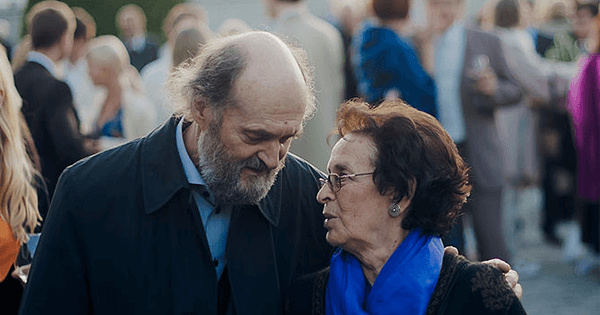
Lately, my reading has followed a predictable pattern. The Plot Against America, 1984, The Aerodrome, The Drowned World—these are the books, both familiar and new, that have accompanied me on the subway during my morning commute. As if the daily news weren’t unsettling enough—as if my inability to get through even 10 minutes of work without clicking on The Guardian or The New York Times weren’t a sign of some serious degradation of spirit and mind—I find myself increasingly drawn to alternate histories, to dystopian visions, to depictions of totalitarianism and environmental catastrophe. To find some traces of our bewildering present in the wildest imaginings of Western literature is, I think, a perverse form of consolation. But what I can’t seem to escape is the constant static in my head, or the strange compulsion to keep the static alive.
This can’t be healthy. So music—specifically the music of Arvo Pärt—has provided the necessary corrective. I learned to play Pärt’s Fratres (the version for violin and piano) in college, back in the early 1990s, and though the piece held some appeal at the time, it was more of a novelty for me than anything else. I hadn’t yet heard the phrase “holy minimalism,” often associated with Pärt’s music, but Fratres was a little too New Age for someone seduced by the more obvious complexities of Witold Lutosławski or Arnold Schoenberg. Only now, in my rediscovery of Pärt, do I realize how fooled I’d been by the deceptive simplicity of the music.
Arguably the most popular of living composers, Pärt was born in Estonia in 1935. His early works bear the influences of Dmitri Shostakovich and Serge Prokofiev, but he also dabbled in 12-tone serialism and various avant-garde techniques. At times violently dissonant, his music was very much of its time, and the ultra-conservative Soviet establishment was bound to disapprove. In 1960, Pärt’s Nekrolog, an expressionist 12-tone piece, drew a rebuke from Tikhon Khrennikov, secretary of the Union of Soviet Composers. The works that followed, including two striking symphonies, did not bend to any clenched iron fist, yet Pärt himself would become weary of the direction his music was taking. Faced with a creative crisis, he withdrew from public view and entered a sustained period of contemplation. He converted to the Russian Orthodox faith and studied Gregorian chant, as well as medieval and Renaissance music. For almost eight years, he composed nothing at all.
Pärt’s Third Symphony, written in 1971, marked his return, its idiom harking back to the very beginnings of Western polyphonic music. Many of his later pieces would take their inspiration from sacred texts, but even his secular pieces were austere and meditative, for example, Tabula Rasa (1977), a reinvention of the Baroque concerto grosso, in this case, with two violin soloists and a small chamber ensemble providing the accompaniment; the Cantus in Memory of Benjamin Britten (1977), in which a bell tolls a repeated A; Fratres (1977), with its torrent of arpeggios, its periods of stillness and quiet, its passages that sound almost primordial; and Spiegel im Spiegel (1978), its incantatory three-note piano motif very much like the famous opening of Beethoven’s Moonlight Sonata, though here the mood is pure and innocent, not funereal, as if Pärt were recalling some lost fragment from his childhood. The new style had a name: tintinnabuli, or, like the ringing of bells. The harmonies were elementary, and Pärt’s reliance on the triad (the building block of tonal music) would have horrified Schoenberg at his most didactic. Nevertheless, this music—governed by a strictness of form, with its repetitions and variations—is both serene and intense. The effect on the listener willing to surrender to it can be powerful, soothing, and restorative.
For Pärt, silence will always be as important as sound. When the violinists Gidon Kremer and Tatjana Grindenko first looked at the score of Tabula Rasa, they were mystified by the virtually empty pages—vast stretches of white upon which were notated a seemingly scarce number of notes. Tabula Rasa appears to ask more questions than it answers: How does the imagination fill in the gaps during those profound moments of quiet? How do we train our minds (Pärt would say, our souls) to resist the distractions of the outside world and simply luxuriate in those silences?
Recently, I have begun listening to Tabula Rasa at night, while lying in bed, the glow of my iPod screen lasting only a few seconds before I am immersed in near darkness—this is when the piece begins to work its magic. Prominent is the prepared piano, with metal screws placed behind the instrument’s dampers, so that it sounds otherworldly, almost like the Indonesian gamelan. In the second movement, titled “Silentium,” the prepared piano regularly plays an eerie rising arpeggio, as the stringed instruments sing a melody of almost hypnotic simplicity. As the movement progresses, that arpeggio is heard more and more infrequently, to the point where I am anxious—desperate even—for those notes to sound, and relieved when they finally do. This music reminds me of many things: a vibrant winter’s sunset, the starry cosmos, birds flitting across an empty, frozen plain. Ultimately, however, none of these metaphors will suffice. This music simply is. It’s the thing in itself.
At the end of Tabula Rasa, after the final whispered notes in the double basses, the music continues to play in my head, in the silence and the darkness, too alive a thing to die. The violins still circle each other, taking flight, floating, and descending, with the haunting chimes of the prepared piano still resonant in my head, as well. There is sadness here, there is beauty, there is relief from the violence and pain of the earthly world. And this is the illusion cast by Pärt’s music: the present moment of our lives becomes wonderfully ephemeral. Only the music extends into eternity.

